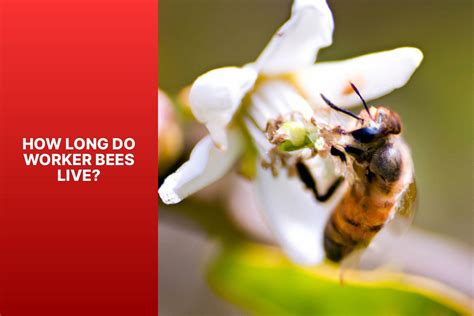How Long Do Worker Bees Live

The lifespan of worker bees, which are female bees that perform most of the tasks within a colony, is a fascinating topic that highlights the intricate social structure of these incredibly organized creatures. Worker bees are responsible for foraging, caring for young, building the hive, and defending the colony, among other duties. The duration of their lives is closely tied to the time of year and the specific role they play within the colony.
In general, the lifespan of a worker bee varies significantly depending on when they emerge from their brood cells. Bees that emerge during the summer, when the colony is at its peak activity and the demand for foragers, caregivers, and builders is high, typically live for about 4 to 6 weeks. This short lifespan is due to the high level of physical activity and the wear and tear associated with foraging, which is a dangerous task. Foragers are exposed to predators, harsh weather conditions, and the risk of getting killed while collecting nectar, pollen, or water. Additionally, the process of foraging itself is energetically costly, contributing to their relatively short lifespan.
On the other hand, bees that emerge in the fall, as the days shorten and the colony prepares for winter, have a longer lifespan. These bees, often referred to as “winter bees,” can live for 4 to 6 months. The extended lifespan of winter bees is crucial for the survival of the colony, as they must survive the cold winter months when there is little to no foraging activity. During this time, the colony’s population dwindles significantly due to the death of summer bees, and the winter bees take on the role of clustering around the queen to keep her warm and ensuring the colony’s survival until spring arrives.
The difference in lifespan between summer and winter bees is largely due to the level of physical activity and the energy reserves they have. Winter bees have a higher store of fat reserves, which helps them survive the winter. Moreover, they are less active than summer bees, dedicating their energy to maintaining the colony’s temperature and ensuring its survival rather than foraging and other energy-intensive tasks.
It’s also worth noting that the lifespan of worker bees can be influenced by various factors such as diet, disease, and environmental conditions. A diet rich in pollen and nectar can support the health and longevity of bees, while the presence of diseases or parasites can significantly shorten their lifespan. Environmental factors, including pesticide use, climate change, and habitat loss, also play a crucial role in determining the health and survival rate of bee colonies.
In contrast to worker bees, the queen bee, who is responsible for laying eggs, can live for up to 5 years or more, although the average lifespan is typically around 2 to 3 years. The longevity of the queen is crucial for the colony’s continuity and success, as she is the only fertile female in the colony and her pheromones play a key role in regulating the social behavior of the workers.
The social hierarchy and division of labor within a bee colony are truly remarkable, with each member playing a vital role in the colony’s survival and prosperity. The lifespan of worker bees, while relatively short compared to some other insects, is a testament to their hard work and dedication to the colony, highlighting the intricate and fascinating world of these social creatures.
Understanding the factors that influence the lifespan of worker bees can provide valuable insights into the health and resilience of bee colonies. As we face challenges such as colony collapse disorder and the impacts of environmental changes on pollinator populations, knowledge about the biology and social structure of bees becomes increasingly important for developing effective conservation strategies.
What is the average lifespan of a worker bee during the summer?
+The average lifespan of a worker bee during the summer is approximately 4 to 6 weeks, due to the high level of physical activity and the risks associated with foraging.
Why do winter bees live longer than summer bees?
+Winter bees live longer because they have a higher store of fat reserves, are less active, and dedicate their energy to keeping the queen warm and ensuring the colony's survival through the winter, rather than foraging and other energy-intensive tasks.
What factors can influence the lifespan of worker bees?
+Factors such as diet, disease, environmental conditions, pesticide use, climate change, and habitat loss can all influence the lifespan of worker bees, affecting the overall health and survival rate of bee colonies.
The complex social dynamics and biological adaptations of bees are subjects of ongoing research and fascination. By exploring these topics in depth, we not only gain a deeper appreciation for the natural world but also uncover insights that can help us better manage and protect these vital pollinators.

